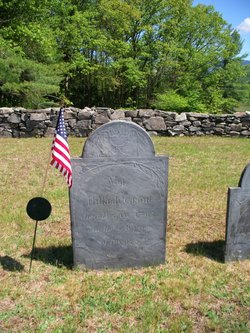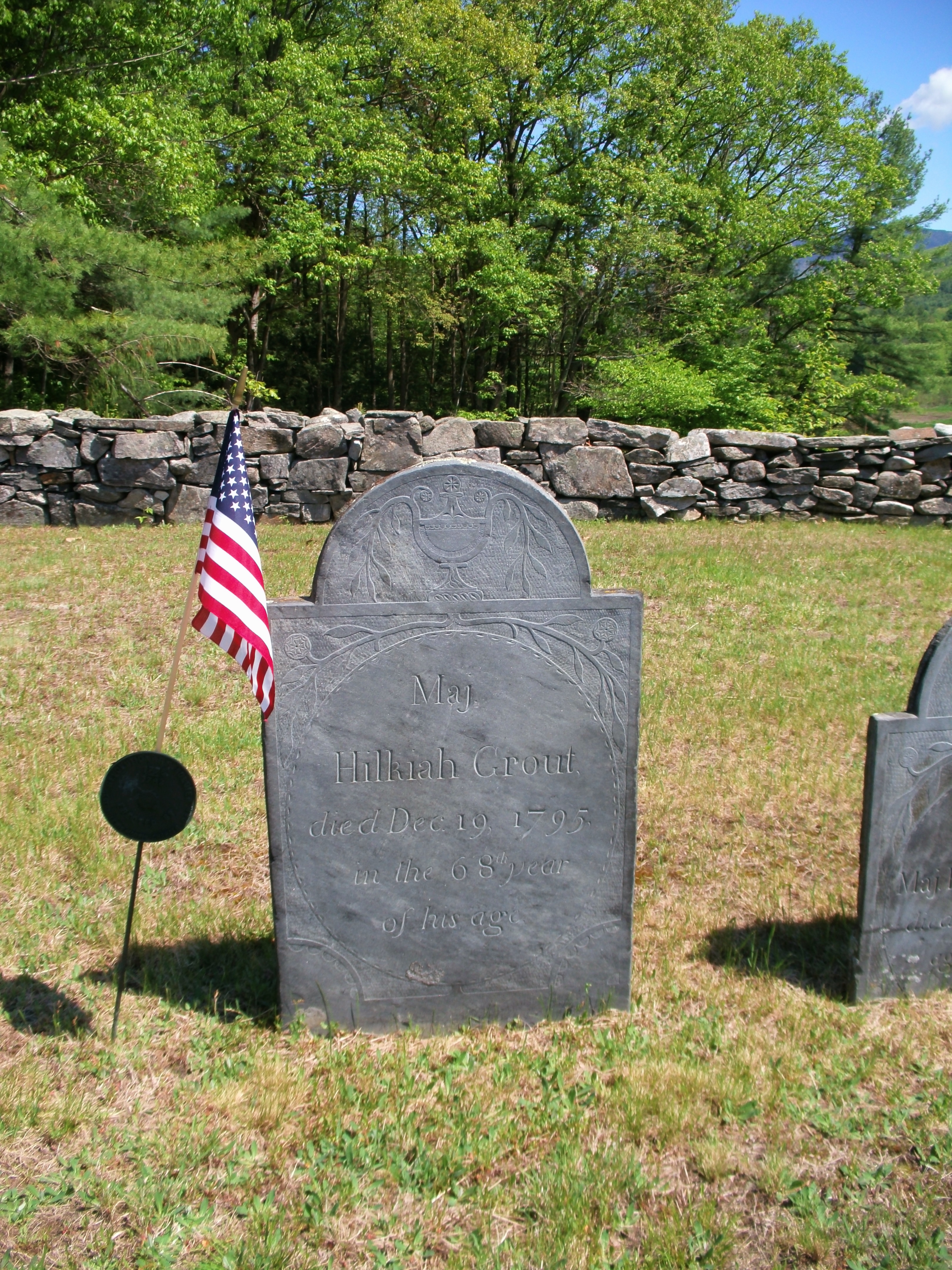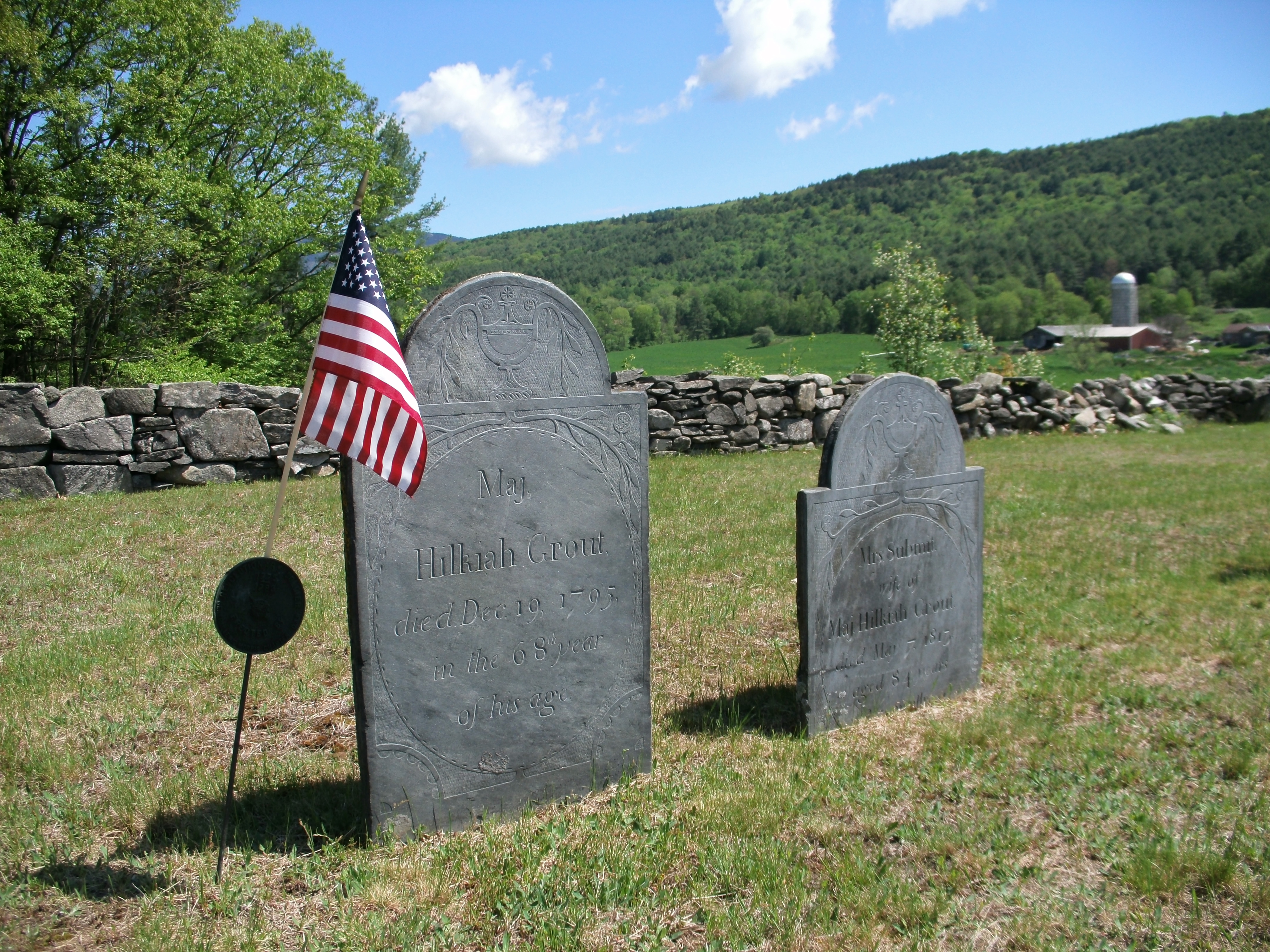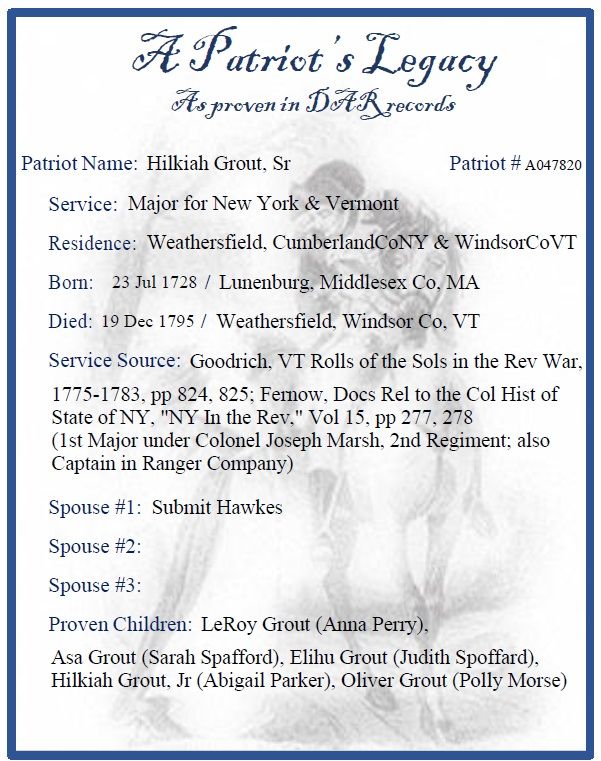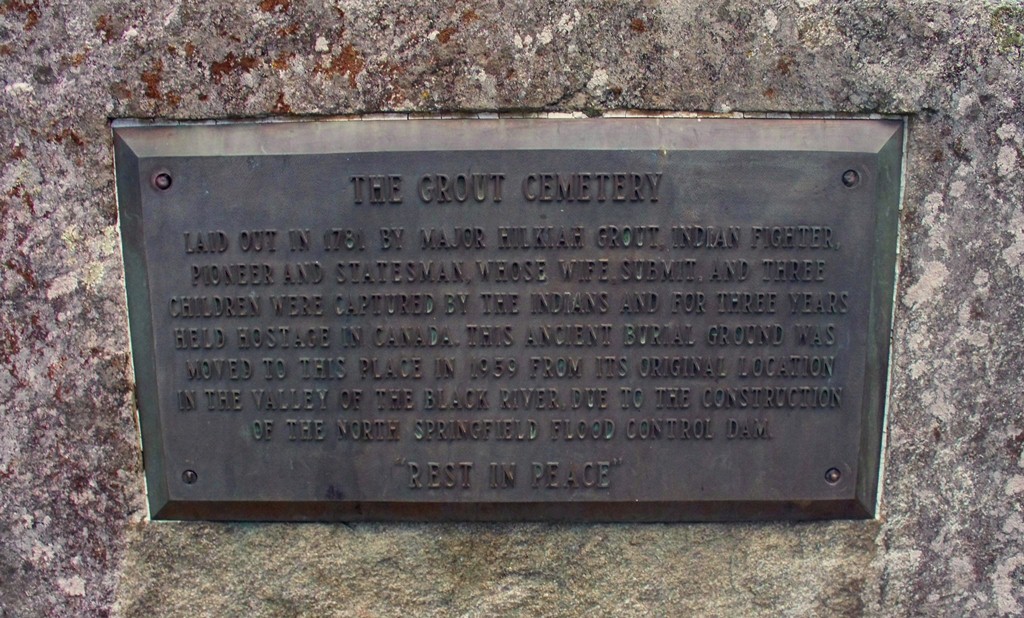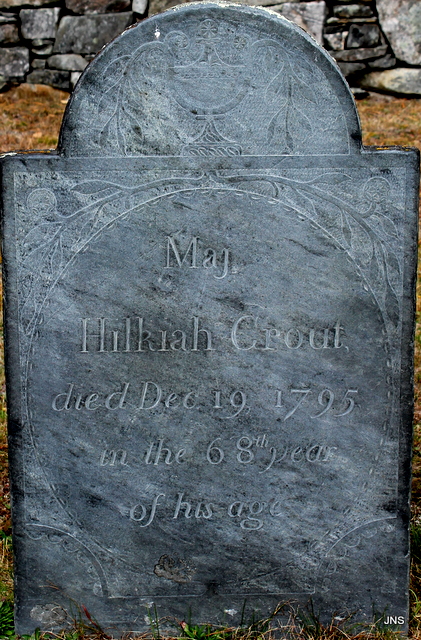Orlando Bridgeman had built a fort at Vernon in 1754. Hilkia Grout with wife Submit Hawkes and their three children,togeather with two other famlies,moved there.The two other families were Caleb Howe with wife Jemima Howe , and Benjamin Gaffield with his wife Unice.On July 27, 1755, the three wives with their children,eleven in all,were alone at the fort. Their men were in the cornfield near the river. They had started to return to the fort, when twelve Abenaki Indians fired upon them in a ambush.Hilkia Grout escaped by swimming across the Connecticut river.Benjamin Gaffield attempted the same but was drowned. The three older Howe boys were captured, and their father Caleb Howe was scalped, his body pierced by a spear, was left for dead. He was found alive the next moring by a party from Fort Hinsdale,but died soon after. Some old records state that the Indians had learned the signal given to open the gate by keeping watch.This enabled them to make an easy entrance of the fort.The women had heard the guns, and anxiously awaiting the return of their men,heard in the early evening dusk,a rapping at the gate and a tread of feet about.Supposing their men had returned safely, they opened the gate. What horror and anguish must have been theirs as the hideously painted Indians burst in upon them.The three families were made prisoners,the fort was plundered and set on fire.The Indians then proceeding with their prisoners about a mile and a half into the forest,where they encamped for the night.Early the next morning they set out to the place where they had left their canoes,which was about fifteen miles south of Crown Point,N.Y.The journey taking a total of about eight days to cross this stretch of the Green Mountains. From here it would be another nine days though woods and swamps, across hills and streams, half clothed, barefoot, exposed to the pitiless midsummer heat, the vicious sting of black flies, mosquitoes and other insects with which the northern woods abound at that time of year.After much suffering they finally reached Crown Point on Lake Champlain. Submit Grout with the rest of the prisoners were sent on to Montreal to be sold to the French.When no market was found for their sale they were brought back with the exception of the youngest daughter who was given as a gift to Govenor De Vaudreuil.Having returned to their encampment on Lake Champlain.The next evening they all embarked in the canoes,just as night was approaching.The travel at night was treacherous though a intense thunder storm as they approached St John .It was sheer luck that they survived the wind and the waves that night on the lake.A little before day break they landed on the beach weary and beaten from the night on the lake during a storm.Eventually they made is to St Johns where Mrs Howe was hastily sold.Submit Grout and the rest of the prisoners continued on to St Frances
There has always been an unsupported tradition that Hilkia Grout followed the Indians and their captives for three days, saw that his wife and children were alive and not being treated brutally, and knew that a pot shot from him would be hazardous to their welfare. From a vantage point on the Black River Meadows, where he later settled and built a home, he saw them disappear into the forest. He then returned and enlisted for Indian warfare. The unual termination of an Indian raid was that those who survived the long march were sold, the boys to Indians, the women to the French as household servants. , Submit and Martha were so fortunate as to be sold together to a French gentleman,Monsieur LeRoy DeMille. Asa and Hilkiah Jr. were taken to the Indians in the St. Francis region., Submit and Martha were captives there for three years.On October 9,1758,Colonel Zadoc Hawkes presented a petition to the General Court of Massachusetts,paying them to obtain a release for, Submit Grout ,and the petitioner's niece. Money for the ransom was contributed by General Israel Putnam and others. The release was not long delayed,and sometime in the next spring, , Submint Grout came home, but was compelled to leave her children in Canada.
Three years later Martha and Asa were recovered, but Hilkiah Jr., was not to return to them. They never saw their first born son again, and for a long time mourned him as dead, naming another little son Hilkiah Jr., II. Evidence was afterwards brought forth that he had been adopted by the Cattaraugus Indians in western New York, grew up with them and as he came into manhood becaime their chief councilor.
It is not recorded when or why Hilkia Grout decided on Weathersfield as a permanent home,Weathersfield was near the old Indian trail the captives had traveled years earlier.He was first elected to town office in 1774, and it is likely that he had been clearing land, bargaining for titles for some years previous, but, none of his children was born in Weathersfield until 1771., Submit Grout had lost nearly four years in Canadian widowhood, and as large families were expected, even considered a responsibility, upon her return from captivity, she again took up her duties as wife and mother. Eight children were born in the thirteen years that followed: Elihu Grout b 1760,Hilkiah Grout Jr.II b 1761, Bridgeman Grout b 1763, Seth Grout b 1765,DeMille Grout b 1767, Oliver Grout b 1769, Orlando Grout b 1771, Leroy(Roy) Grout b 1773.Submit Grout was now forty-five years old with one daughter and ten sons. The names of the children are indicative of those years preceeding their birth. Orlando and Bridgeman in memory of the destroyed fort.LeRoy and DeMille for the kind and gracious French master of her years in captivity. Even in those troublesome times letters were preserved and records of visits exchanged between Montreal and Vermont, with reference to Canadian courtesy shown.With the State of Vermont being established and the French and Indian war over
,Hilkia Grout turned his attention to his properties,and to civic affairs. He was always elected to town office and his influence was such that he always fourn himself on the most important committees.
While the Revolutionary war was in progress, the affairs of the settlers were managed by committees in the various town, who when the occasion required, met in general convention to provide in common defense and general welfare. The decrees of these conventions were regarded as law,and the violations were severly punished.........
Hilkiah is recorded together with his son, Corporal Asa Grout as signing the New York Association test on December 21,1775.A military commitee of Safety was named in 1775 to take charge of all preparations with Hilkia Grout as Captain to have charge at Perkinsville.To him (Hilkiah) and two others was given power, as Commissioners, to admister the oath of office to all civil and military appointees.In 1775 he represented the town at Legislature. He had acquired money and property, buying largely of the proprietors,until he owned all of Black River Meadow land south of lower Perkinsville. He built his log house at the depression east of the highway, 20 rods north of the covered bridge. The brook from the wester plain crossed at this point, and the intervals were covered with wild rank grass. He cleared pastures, built barns, and then a frame house which stood through the years, though doubtless remodeled many times.He loved his farm, establishing his own burial ground just over the garden wall, and that row of family grave stones, inscriptions increasingly clouded with lichen deposit, withstood the elements of 168 years in the place he had laid out, and are still standing in the new cemetery site, which relocation was made necessary in the construction of the North Springfield Flood Control Dam in 1959.Hilkia Grout's lands extended to Kendrick's Corners road where he had a great bubbling spring, know for years as "the Major's Spring."
His children lived with him or around him, marrying into Weathersfield families. All these married sons had children, and as the older sons came of age, they established themselves upon farms of their own. The Second Census, State of Vermont, 1800 lists nine children of Hilkiah and Submit, one with a family of five, two families of six each, three of seven, one of eight, one of nine, one of ten. Sixty-five souls in all, in a town where four weary, frightened Indian captives of the Grout family had passed the night forty-five years before.Hilkia Grout died December 19, 1795,and was buried in the place where he had chosen. He was but 68 years old,living a rich and full life.
History by Helen B Osgood
___________________________________________________________
Military History for Hilkiah Grout is as follows:
STATE OF VERMONT,ROLLS OF THE SOLDIERS OF THE REVOLUTIONARY WAR,1775 to 1783.Hilkiah GROUT served as 1st Major, Upper Regiment,was on a list of Officers for Cumberland County. A note says that the nominations of these Officers was confirmed by the Committee of Safety of New York,January 4, 1776 (from A.H. Hall's History of Eastern Vermont)
___________________________________________________________
Sources..George Sheldon, "History of Deerfield, Massachusets, II Pgs 189 - 190: and Ernest W. Butterfield,"Early History of Weathersfield, Vermont"
Orlando Bridgeman had built a fort at Vernon in 1754. Hilkia Grout with wife Submit Hawkes and their three children,togeather with two other famlies,moved there.The two other families were Caleb Howe with wife Jemima Howe , and Benjamin Gaffield with his wife Unice.On July 27, 1755, the three wives with their children,eleven in all,were alone at the fort. Their men were in the cornfield near the river. They had started to return to the fort, when twelve Abenaki Indians fired upon them in a ambush.Hilkia Grout escaped by swimming across the Connecticut river.Benjamin Gaffield attempted the same but was drowned. The three older Howe boys were captured, and their father Caleb Howe was scalped, his body pierced by a spear, was left for dead. He was found alive the next moring by a party from Fort Hinsdale,but died soon after. Some old records state that the Indians had learned the signal given to open the gate by keeping watch.This enabled them to make an easy entrance of the fort.The women had heard the guns, and anxiously awaiting the return of their men,heard in the early evening dusk,a rapping at the gate and a tread of feet about.Supposing their men had returned safely, they opened the gate. What horror and anguish must have been theirs as the hideously painted Indians burst in upon them.The three families were made prisoners,the fort was plundered and set on fire.The Indians then proceeding with their prisoners about a mile and a half into the forest,where they encamped for the night.Early the next morning they set out to the place where they had left their canoes,which was about fifteen miles south of Crown Point,N.Y.The journey taking a total of about eight days to cross this stretch of the Green Mountains. From here it would be another nine days though woods and swamps, across hills and streams, half clothed, barefoot, exposed to the pitiless midsummer heat, the vicious sting of black flies, mosquitoes and other insects with which the northern woods abound at that time of year.After much suffering they finally reached Crown Point on Lake Champlain. Submit Grout with the rest of the prisoners were sent on to Montreal to be sold to the French.When no market was found for their sale they were brought back with the exception of the youngest daughter who was given as a gift to Govenor De Vaudreuil.Having returned to their encampment on Lake Champlain.The next evening they all embarked in the canoes,just as night was approaching.The travel at night was treacherous though a intense thunder storm as they approached St John .It was sheer luck that they survived the wind and the waves that night on the lake.A little before day break they landed on the beach weary and beaten from the night on the lake during a storm.Eventually they made is to St Johns where Mrs Howe was hastily sold.Submit Grout and the rest of the prisoners continued on to St Frances
There has always been an unsupported tradition that Hilkia Grout followed the Indians and their captives for three days, saw that his wife and children were alive and not being treated brutally, and knew that a pot shot from him would be hazardous to their welfare. From a vantage point on the Black River Meadows, where he later settled and built a home, he saw them disappear into the forest. He then returned and enlisted for Indian warfare. The unual termination of an Indian raid was that those who survived the long march were sold, the boys to Indians, the women to the French as household servants. , Submit and Martha were so fortunate as to be sold together to a French gentleman,Monsieur LeRoy DeMille. Asa and Hilkiah Jr. were taken to the Indians in the St. Francis region., Submit and Martha were captives there for three years.On October 9,1758,Colonel Zadoc Hawkes presented a petition to the General Court of Massachusetts,paying them to obtain a release for, Submit Grout ,and the petitioner's niece. Money for the ransom was contributed by General Israel Putnam and others. The release was not long delayed,and sometime in the next spring, , Submint Grout came home, but was compelled to leave her children in Canada.
Three years later Martha and Asa were recovered, but Hilkiah Jr., was not to return to them. They never saw their first born son again, and for a long time mourned him as dead, naming another little son Hilkiah Jr., II. Evidence was afterwards brought forth that he had been adopted by the Cattaraugus Indians in western New York, grew up with them and as he came into manhood becaime their chief councilor.
It is not recorded when or why Hilkia Grout decided on Weathersfield as a permanent home,Weathersfield was near the old Indian trail the captives had traveled years earlier.He was first elected to town office in 1774, and it is likely that he had been clearing land, bargaining for titles for some years previous, but, none of his children was born in Weathersfield until 1771., Submit Grout had lost nearly four years in Canadian widowhood, and as large families were expected, even considered a responsibility, upon her return from captivity, she again took up her duties as wife and mother. Eight children were born in the thirteen years that followed: Elihu Grout b 1760,Hilkiah Grout Jr.II b 1761, Bridgeman Grout b 1763, Seth Grout b 1765,DeMille Grout b 1767, Oliver Grout b 1769, Orlando Grout b 1771, Leroy(Roy) Grout b 1773.Submit Grout was now forty-five years old with one daughter and ten sons. The names of the children are indicative of those years preceeding their birth. Orlando and Bridgeman in memory of the destroyed fort.LeRoy and DeMille for the kind and gracious French master of her years in captivity. Even in those troublesome times letters were preserved and records of visits exchanged between Montreal and Vermont, with reference to Canadian courtesy shown.With the State of Vermont being established and the French and Indian war over
,Hilkia Grout turned his attention to his properties,and to civic affairs. He was always elected to town office and his influence was such that he always fourn himself on the most important committees.
While the Revolutionary war was in progress, the affairs of the settlers were managed by committees in the various town, who when the occasion required, met in general convention to provide in common defense and general welfare. The decrees of these conventions were regarded as law,and the violations were severly punished.........
Hilkiah is recorded together with his son, Corporal Asa Grout as signing the New York Association test on December 21,1775.A military commitee of Safety was named in 1775 to take charge of all preparations with Hilkia Grout as Captain to have charge at Perkinsville.To him (Hilkiah) and two others was given power, as Commissioners, to admister the oath of office to all civil and military appointees.In 1775 he represented the town at Legislature. He had acquired money and property, buying largely of the proprietors,until he owned all of Black River Meadow land south of lower Perkinsville. He built his log house at the depression east of the highway, 20 rods north of the covered bridge. The brook from the wester plain crossed at this point, and the intervals were covered with wild rank grass. He cleared pastures, built barns, and then a frame house which stood through the years, though doubtless remodeled many times.He loved his farm, establishing his own burial ground just over the garden wall, and that row of family grave stones, inscriptions increasingly clouded with lichen deposit, withstood the elements of 168 years in the place he had laid out, and are still standing in the new cemetery site, which relocation was made necessary in the construction of the North Springfield Flood Control Dam in 1959.Hilkia Grout's lands extended to Kendrick's Corners road where he had a great bubbling spring, know for years as "the Major's Spring."
His children lived with him or around him, marrying into Weathersfield families. All these married sons had children, and as the older sons came of age, they established themselves upon farms of their own. The Second Census, State of Vermont, 1800 lists nine children of Hilkiah and Submit, one with a family of five, two families of six each, three of seven, one of eight, one of nine, one of ten. Sixty-five souls in all, in a town where four weary, frightened Indian captives of the Grout family had passed the night forty-five years before.Hilkia Grout died December 19, 1795,and was buried in the place where he had chosen. He was but 68 years old,living a rich and full life.
History by Helen B Osgood
___________________________________________________________
Military History for Hilkiah Grout is as follows:
STATE OF VERMONT,ROLLS OF THE SOLDIERS OF THE REVOLUTIONARY WAR,1775 to 1783.Hilkiah GROUT served as 1st Major, Upper Regiment,was on a list of Officers for Cumberland County. A note says that the nominations of these Officers was confirmed by the Committee of Safety of New York,January 4, 1776 (from A.H. Hall's History of Eastern Vermont)
___________________________________________________________
Sources..George Sheldon, "History of Deerfield, Massachusets, II Pgs 189 - 190: and Ernest W. Butterfield,"Early History of Weathersfield, Vermont"
Family Members
Advertisement
Records on Ancestry
Advertisement
